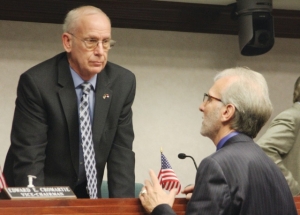Commissioners put conditions on Board of Education's plans for school construction
By Steve Herring
Published in News on February 19, 2014 1:46 PM

News-Argus/STEVE HERRING
School superintendent Dr. Steve Taylor, right, speaks with Commission Chairman Wayne Aycock Tuesday morning after commissioners voted 4-3 to require the schools to use design/build to construct new schools. Aycock voted against the requirement.

News-Argus/STEVE HERRING
Wayne County Commissioner Joe Daughtery, right, refuses to be swayed by arguments by school architect and developer Robert Ferris that design/build is not suited for schools and would not save any money. Daughtery finally walked away saying he would not vote to raise taxes.
Wayne County School Board officials shook their heads, murmured, and traded glances as Wayne County commissioners by a 4-3 vote Tuesday morning told them they could continue with their plans for two new schools, but that they had to use the design/build method to construct them.
Other than the use of design/build -- in which an architect and general contractor form a team that works under one contract, providing both design and construction services -- commissioners appeared to support the remainder of the school board's plan.
The motion approved by commissioners did not directly address the cost of the projects or whether the schools would be "high performance," meaning energy efficient. Nor did it specify how the projects would be financed.
The Board of Education had asked for $40 million to build high-performance middle schools in the Grantham and Spring Creek communities.
But its preferred delivery method was for school architect and developer Robert Ferris, president and CEO of SfL+a, to build the schools and then lease them back to the county for five years, after which the county would buy out the lease.
Commissioners on the other hand have supported a $30 million project to build traditional schools using the design/build method.
Last week, during a Friday night special session, the Board of Education voted to proceed with its plan to build the two schools. All seven commissioners attended the meeting, which included a presentation by Ferris. Under its plan, the school board would make a $5 million down payment and would pay the annual $3.2 million payment from existing sales tax and lottery reserves.
The school board had wanted commissioners to act quickly to endorse the plan to meet a timetable to get the financing request to the Local Government Commission for approval in April. That would allow the process to get under way so that the schools would be ready to open in August 2015, Ferris said.
Commissioners, during their Tuesday morning agenda briefing, agreed to a request by Commissioner Ed Cromartie to add the school board's resolution to proceed with the project to their agenda.
However, the commissioners' vote to proceed using design/build made action on the resolution a moot point, and it was never discussed.
Instead the board approved by a 4-3 margin a motion by Commissioner Steve Keen, "To support and approve the Board of Education's recommendation to build Grantham Middle School and Spring Creek Middle School, which includes the auditoriums, in compliance with DPI and STEM, utilizing the design/build method with Davenport oversight to comply with Local Government Commission recommendations."
Davenport & Co. is the county's financial consultant.
Commissioner John Bell asked Keen if he would withdraw his motion.
When Keen refused, Bell offered an amendment to the motion that the school board continue with the plan it had outlined during Friday's meeting.
"The best way for this county to move forward is, No. 1, in education is to trust the school board," Keen started.
"That is what I am saying," Bell said.
"That is the first thing Mr. Chairman and fellow commissioners," Keen said. "You (Bell) didn't say that. I am saying that. I am telling the people right now the best way we can move forward in education is to trust the school board.
"But I want them to trust us because it works both ways. We have asked some great questions. Just like you (Ferris) presented your case to the school board Friday. But the school board has got to trust us in funding."
Keen said the majority of the new board of commissioners said at the start of its term that its priority was education and cutting taxes and spending.
He said the board had reduced the tax rate so that the county could afford to improve education.
Cromartie reminded commissioners that doing all of the projects on their capital improvement plan would require a 16-cent increase on the county property tax rate.
People need to realize that if they want things done that the money has got to come from somewhere, he said.
Bell's amendment failed 5-2. Bell and Cromartie voted yes. Keen and Commissioners Bill Pate, Wayne Aycock, Joe Daughtery and Ray Mayo voted no.
Keen's motion was approved 4-3, with Keen, Pate, Daughtery and Mayo voting yes. Bell, Cromartie and Aycock voted no.
Commissioners, particularly Daughtery, questioned the county's ability to pay the $3.2 million annual project payment without increasing the tax rate.
School officials said they had calculated the equation and said they do have the money to make the payments.
The school board plans to use sales tax and lottery funds to pay for the schools.
During Tuesday's meeting, financial consultants with Davenport & Co. had suggested that new school construction be funded through general obligation bonds.
However, Daughtery said the school board's figure failed to include the more than $800,000 that would be needed annually in operating costs for the two schools.
To support their insistence on using design/build, commissioners held up the new Senior Center and Steele Memorial Library in Mount Olive as evidence it not only works, but saves money.
Commissioners were not swayed by arguments to the contrary by Ferris, who said design/build is not cost-effective for school construction.
Ferris said his company does design/build projects and he could build cheap schools, but it would not save the county any money.
The process is fine for simple warehouse-type projects, but not for more complex ones such as schools, he said.
Also, the high-performance process allows the projects to move up to nine months quicker than traditional projects, locking in costs before inflation can force them up, he said.
"You will lose time (with design/build)," Ferris said. "There is no way you can be in it by August of 2015 under that method even though that design is arguably complete. You will lose the interest rate.
"It will cost more money. So you will either cut scope or spend more money. You will do one or the other. So your interest rate is going to be higher and you are not going to meet the schedule."
As the developer, Ferris said there are two financing options -- one is selling something similar to bonds and the other is private financing through a bank.
Ferris said he prefers the private funding, which could save money.
Also, the high-performance schools use solar energy to generate enough electricity to power them and still be able to make money by selling the excess power to electric companies, he said.
